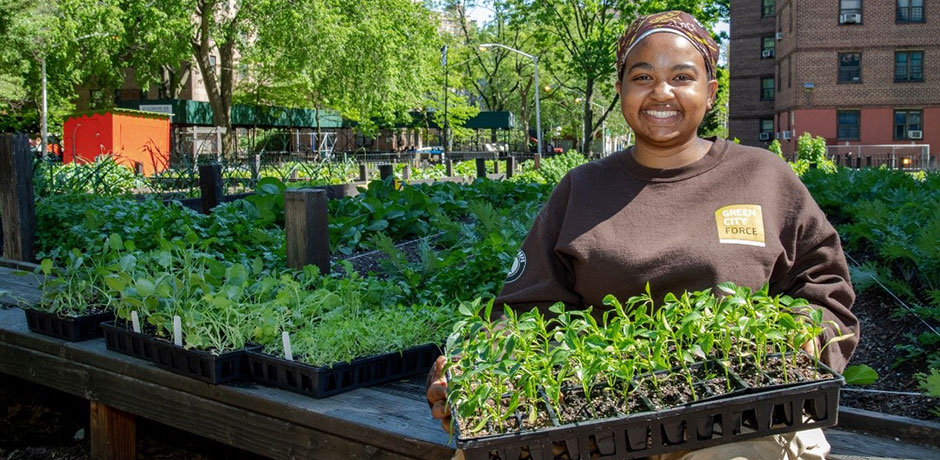City Blooming Can Be Fun For Anyone
City Blooming Can Be Fun For Anyone
Blog Article
The 6-Minute Rule for City Blooming
Table of ContentsThe 45-Second Trick For City BloomingWhat Does City Blooming Do?An Unbiased View of City BloomingCity Blooming Fundamentals ExplainedThe Ultimate Guide To City Blooming
Intrigued in growing food for sale in the City of Chicago? Considering starting an area garden? Changes to the Chicago Zoning Regulation allow farming usages like area yards and urban ranches in lots of components of the city. Below is a listing of often asked concerns concerning the rules and policies that growers ought to think about when intending a city farming task.
The zoning change does not customize any type of various other codes taking care of composting, structure licenses, buying or leasing City owned building, business licenses or ecological contamination. There are existing codes that manage these problems and they stay in full effect and might be appropriate to your task. Community gardens are usually had or handled by public entities, public organizations or community-based organizations and kept by volunteers.
Urban ranches expand food that is meant to be sold, either on a not-for-profit or for-profit basis. Due to their business objective, city farms require a company license.
Indicators on City Blooming You Should Know
The quantity of compost material can not surpass 25 cubic yards at any kind of offered time according to the requirements in 7-28-715 of the City's Municipal Code. Because the soil at most brand-new garden websites needs amending, garden compost, soil, timber chips, or other materials can be gotten to build or boost the expanding space.

If a building authorization is needed then the hoophouse will be taken into consideration an accessory building. You can discover more about the building permit requirements by speaking to the Division of Buildings. The 25,000-square-foot dimension limitation is intended to stop a single community yard from dominating an offered block or interfering with the block's existing domestic or business personality.
The restriction does not use to yards situated in Public Open Space (POS) districts. Can there be greater than one area garden that is 25,000 square feet on a single block? Yes. The dimension restriction puts on private gardens, not to private blocks. No. Secure fencing is not called for, nevertheless, gardens that have big parking lot may be needed to install secure fencing or other landscape design features.
An Unbiased View of City Blooming
B1 & B2 areas call for that all business use activities be performed inside. R districts limit business activity. The laws reflect the purpose and intent of the Zoning Code. Is fence required for urban ranches? Yes. Fencings may be called for, along with landscaping and testing, for particular car park areas and outside work or storage locations depending on place and the specific activity happening.
Yes. Urban ranches need structure permits and zoning approvals before building. Various other forms of city testimonial might be needed depending on details structures, activities, dimension, landscape design, licensing, public heath and stormwater monitoring issues. A lot of these requirements are recognized in the task design or allowing procedure, however, the applicant might be responsible to separately determine specific licenses or allows that may be needed.
Yes. The sort of permit is determined by what is occurring at the site. The Department of Organization Affairs and Customer Protection can help figure out the particular kind of service permit that's needed. Yes. Off street car parking is required for many business tasks in Chicago. The required number of garage is based on the number of workers servicing website and not the square footage of the growing area.
The Only Guide to City Blooming

An urban ranch can sell compost product created on website, however, the operation should abide with the policies in 7-28-715 of the Chicago Municipal Code. Aquaponic systems are permitted inside your home on metropolitan ranches in numerous zoning areas.
Up to five hives or colonies of honey bees may be kept as an accessory usage. Beekeepers have to register click for info with the Illinois Division of Agriculture. To learn more concerning the proposed zoning modification you may call the Division of Housing and Economic Advancement, Bureau of Preparation and Zoning at 312.744.8563.
Farming in cities and metropolitan locations A city farm in Chicago. Urban farming describes various techniques of growing. https://www.gaiaonline.com/profiles/cityblooming/46731693/, handling, and dispersing food in metropolitan locations. The term also uses to the area activities of animal husbandry, aquaculture, beekeeping, and gardening in a city context. Urban farming is distinguished from peri-urban agriculture, which takes location in rural areas at the edge of suburban areas.
City Blooming - An Overview
, that seek to create social networks started on a shared ethos of nature and area holism. These networks can create by way of official institutional assistance, coming to be integrated right into local town preparation as a "change community" activity for lasting urban development.
Some of the first proof of metropolitan agriculture comes from Mesopotamia.
Report this page